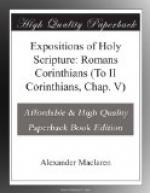That thought may be true about ourselves when it comes to our turn to die, and, thank God, has been true about all those who have departed in His faith and fear. Some of you may have seen two very striking engravings by a great, though somewhat unknown artist, representing Death as the Destroyer, and Death as the Friend. In the one case he comes into a scene of wild revelry, and there at his feet lie, stark and stiff, corpses in their gay clothing and with garlands on their brows, and feasters and musicians are flying in terror from the cowled Skeleton. In the other he comes into a quiet church belfry, where an aged saint sits with folded arms and closed eyes, and an open Bible by his side, and endless peace upon the wearied face. The window is flung wide to the sunrise, and on its sill perches a bird that gives forth its morning song. The cowled figure has brought rest to the weary, and the glad dawning of a new life to the aged, and is a friend. The two pictures are better than all the poor words that I can say. It depends on the people to whom he comes, whether he comes as a destroyer or as a helper. Of course, for all of us the mere physical facts remain the same, the pangs and the pain, the slow torture of the loosing of the bond, or the sharp agony of its instantaneous rending apart. But we have gone but a very little way into life and its experiences, if we have not learnt that identity of circumstances may cover profound difference of essentials, and that the same experiences may have wholly different messages and meanings to two people who are equally implicated in them. Thus, while the physical fact remains the same for all, the whole bearing of it may so differ that Death to one man will be a Destroyer, while to another it is a Friend.
For, if we come to analyse the thoughts of humanity about the last act in human life on earth, what is it that makes the dread darkness of death, which all men know, though they so seldom think of it? I suppose, first of all, if we seek to question our feelings, that which makes Death a foe to the ordinary experience is, that it is like a step off the edge of a precipice in a fog; a step into a dim condition of which the imagination can form no conception, because it has no experience, and all imagination’s pictures are painted with pigments drawn from our past. Because it is impossible for a man to have any clear vision of what it is that is coming to meet him, and he cannot tell ‘in that sleep what dreams may come,’ he shrinks, as we all shrink, from a step into the vast Inane, the dim Unknown. But the Gospel comes and says, ‘It is a land of great darkness,’ but ‘To the people that sit in darkness a great light hath shined.’
’Our knowledge of that life is small,
The eye of faith is dim.’
But faith has an eye, and there is light, and this we can see—One face whose brightness scatters all the gloom, One Person who has not ceased to be the Sun of Righteousness with healing in His beams, even in the darkness of the grave. Therefore, one at least of the repellent features which, to the timorous heart, makes Death a foe, is gone, when we know that the known Christ fills the Unknown.




